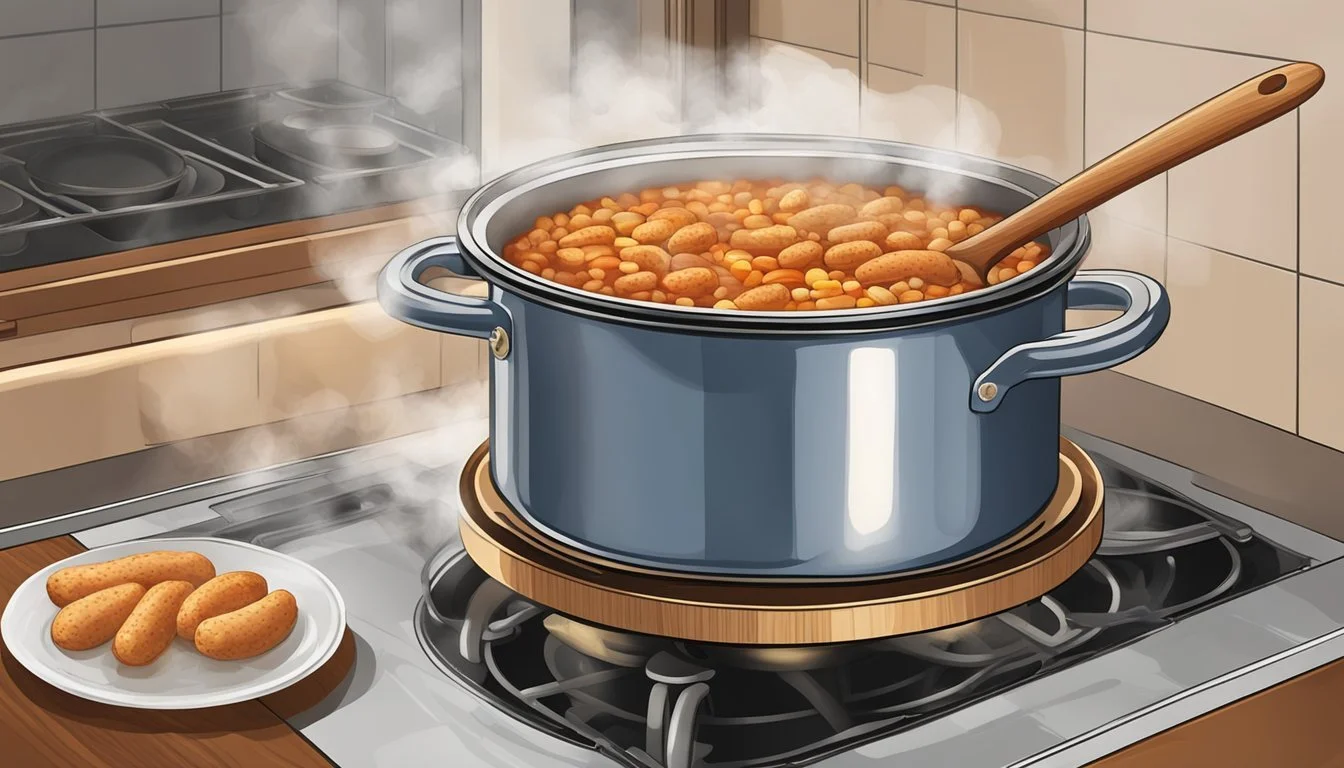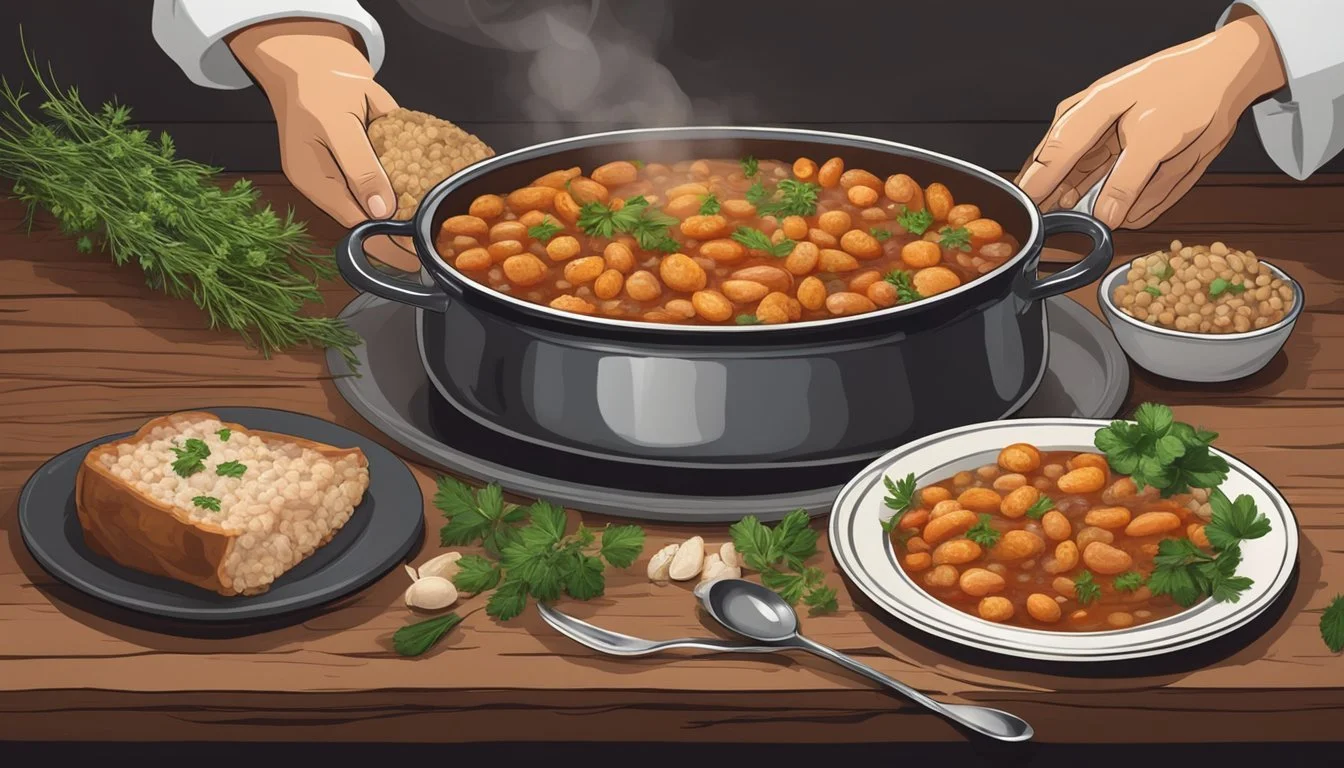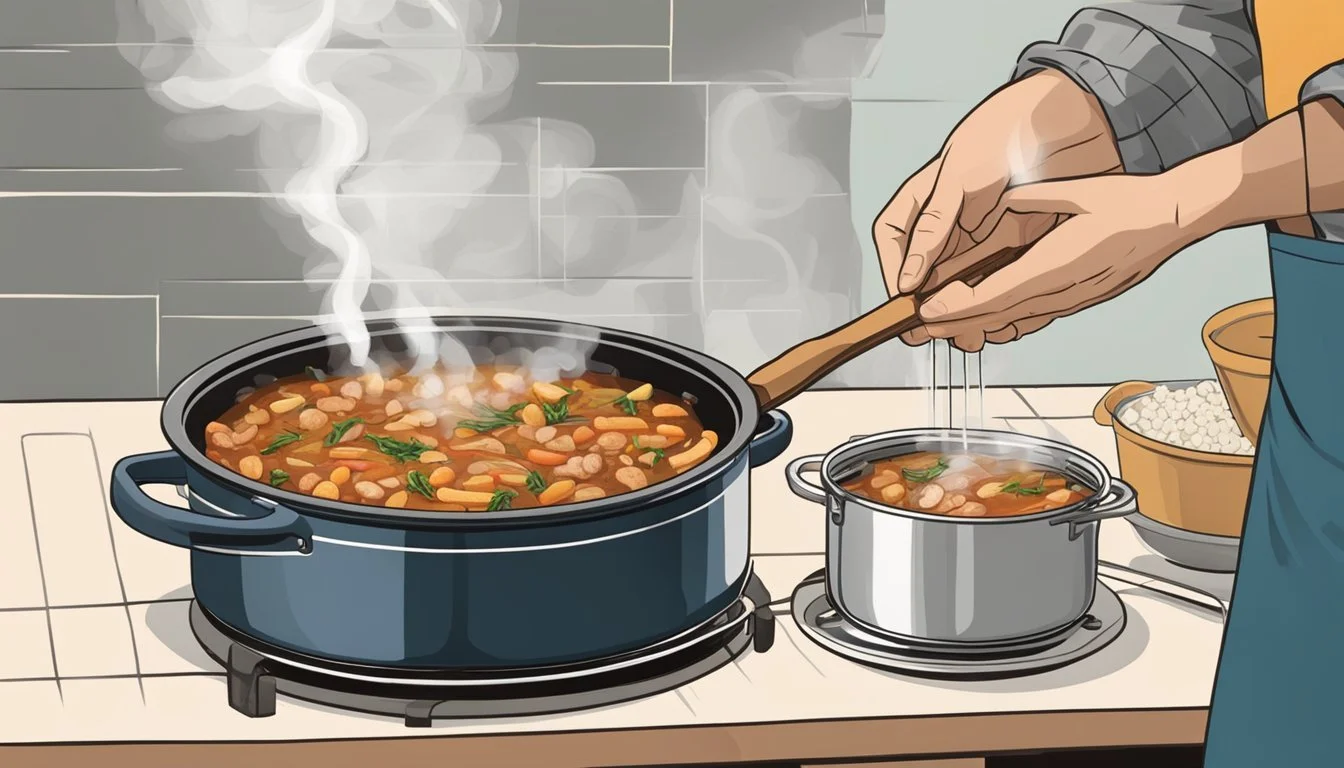Best Way to Reheat a Cassoulet
Preserving Its Deep, Hearty Taste
Cassoulet is a classic French dish that incorporates a rich blend of meats and white beans, slowly cooked to a savory perfection. Its complexity of flavors comes from the lengthy stewing process which allows the individual ingredients to meld together into a harmonious whole. When reheating cassoulet, care must be taken to preserve the integrity of its flavors and textures that have developed over hours of cooking.
The challenge lies in warming the cassoulet thoroughly without drying it out or causing the delicate balance of its juices to evaporate. The solution is not to rush the process; gentle reheating allows the rich flavors to re-emerge without compromising the succulence of the meats or the softness of the beans. An oven, set to the right temperature, can effectively warm the dish through, replicating the slow-cooking environment in which cassoulet thrives.
Avoiding the microwave is generally advised, as its uneven heating can damage the nuanced layers of taste. Instead, the preference leans towards methods that embrace even, ambient heat. Such techniques ensure that the cassoulet's signature depth of flavor and tender texture is not only retained but also enhanced, creating an almost fresh-cooked feel upon serving.
Understanding Cassoulet
Cassoulet is a French culinary masterpiece rooted in rich flavors and comforting textures. This section explores its fundamental makeup and the art of reheating this dish while preserving its essence.
Components of a Cassoulet
A cassoulet is traditionally composed of white beans such as navy or cannellini, a variety of proteins including pork sausage, duck (What wine goes well with duck?) confit (What wine goes well with duck confit?), and sometimes meat like pork or mutton. It is often enhanced with a fragrant broth and a mélange of herbs, creating a symphony of flavors and textures.
Meats and Sausages: Pork sausage, duck confit, and other meats
Beans: Navy beans, cannellini beans
Flavors: Herbs like thyme and rosemary, garlic
Textures: Soft beans, tender meats
The Significance of Proper Reheating
Reheating cassoulet with care is crucial, as it ensures that the flavors meld together without drying out or losing the nuances. The methodology preserves the dish's integrity, sustaining the slow-cooked sensation synonymous with a proper cassoulet.
Preserving Cassoulet's Richness
The key to preserving the cassoulet's hearty flavor lies in the fat and broth components. When reheated, these elements should emulsify, coating the beans and proteins evenly, thus maintaining the dish's signature richness without compromising its desired texture.
Cassoulet's Nutritional Profile
Rich in protein and fiber, a cassoulet's nutritional profile is as hearty as its taste. Inherent to the dish are the nutritional values provided by its components:
Proteins: Essential for muscle repair and growth
Fiber: Hailing primarily from beans, promoting a healthy digestive system
Fat: Mostly derived from meat, lending calories and flavor
Cassoulet offers a balanced meal that is both indulgent and nutritious, with each element bringing forth distinct dietary benefits.
Pre-Reheating Preparation
Properly preparing a cassoulet for reheating is crucial to preserve its rich flavors. The section below will guide the reader through the essential steps of thawing if the cassoulet is frozen, and bringing the dish to an optimal temperature before the reheating process begins.
Thawing Frozen Cassoulet
If the cassoulet has been frozen, it should be transferred from the freezer to the refrigerator well in advance of reheating to ensure a gradual defrost. Defrosting might take anywhere from 12 to 24 hours depending on the size of the portion.
Bringing to Room Temperature
Once fully defrosted, or if starting with refrigerated leftovers, the cassoulet should be brought to room temperature. This can take about 30 minutes and will promote even reheating, helping to maintain the dish's texture and flavors. It is recommended not to leave the cassoulet out for more than two hours to prevent any food safety risk.
Reheating Techniques
Proper reheating methods are vital to preserving the texture and flavor of a cassoulet. The following techniques ensure that the dish remains moist and delicious without compromising its integrity.
Oven Method
For those aiming for evenly reheated cassoulet with preserved texture, the oven is a superior choice. One should preheat the oven to 350°F (175°C). Place the cassoulet in an oven-safe dish, covering it loosely with aluminum foil to prevent drying out. Heat the dish for about 30 minutes or until it reaches an internal temperature of 165°F (74°C), checking periodically.
Stovetop Method
When using the stovetop, it's best to place the cassoulet in a Dutch oven or a heavy pot. Add a small amount of water to help retain moisture. Cover and reheat over low heat, stirring occasionally to ensure even heating and prevent sticking. It should gently simmer rather than boil to maintain the cassoulet’s rich flavor and prevent it from falling apart.
Microwave Reheating
The microwave offers the quickest method for reheating small portions. Transfer the cassoulet into a microwave-safe container, add a splash of water to keep it moist, and cover with a microwave-safe lid or plastic wrap, leaving a small vent for steam. Heat on medium power in short increments, stirring in between to distribute the heat. This method is convenient, although it may unevenly heat the dish and slightly alter the texture.
Finishing Touches and Serving
Once the cassoulet is heated through, attention to detail in the final steps is crucial for enhancing its rich flavor and presenting it at its best. Here's how to master the finish.
Seasoning and Aromatics
To bring out the fullness of the cassoulet's flavor, a final seasoning check is essential. One must add salt and black pepper according to taste, ensuring not to overpower the subtle tastes within. Fresh aromatics such as thyme, bay leaves, and finely chopped garlic, when added at the last minute, can rejuvenate the dish's aroma, providing a fresh layer of complexity.
Salt: To taste
Black pepper: Freshly ground, to taste
Thyme: A sprinkle of fresh leaves
Bay leaves: One or two for an aromatic touch
Garlic: Freshly chopped for pungency
Accompaniments
A traditional cassoulet pairs well with simple sides that complement rather than compete with the main dish. A crisp green salad dressed lightly with vinaigrette can offset the richness, while a crusty baguette serves as the perfect vehicle to mop up any remaining broth. For those desiring more vegetables, steamed carrots or other seasonal vegetables lightly seasoned can be a colourful and healthy addition.
Salad: Green salad with a light dressing
Bread: Crusty baguette
Vegetables: Steamed and seasoned carrots and others to preference
Assemble and Garnish
The cassoulet should be assembled with care to preserve the integrity of its components. The meat should be tender and hot. Ladle the cassoulet into serving dishes, ensuring a balance of beans, meat, and broth in each portion. Garnish with a sprinkle of chopped parsley to add a fresh taste and a vibrant pop of color. For a texturally contrasting finish, some may opt for a light sprinkling of buttery breadcrumbs browned to perfection.
Parsley: Freshly chopped for garnish
Breadcrumbs: Optionally toasted and buttered for crunch
Careful attention to these finishing touches will ensure that the cassoulet is served at the peak of its flavor and texture, creating a memorable dining experience.
Storing Cassoulet
Proper storage is essential for maintaining the rich flavors of cassoulet when planning to reheat it later. The process differs slightly depending on whether refrigeration or freezing is chosen, but both methods aim to preserve the dish's quality.
Refrigeration Best Practices
To refrigerate cassoulet effectively, the dish should be allowed to cool to room temperature before storage. It's then best to transfer the cassoulet into a shallow, airtight container to promote even cooling and reduce the risk of bacterial growth. Seal the container tightly with a lid or plastic wrap to limit air exposure. Refrigerated cassoulet typically retains its quality for up to three days.
Freezing and Defrosting Method
For longer storage, cassoulet can be frozen. One should portion the cassoulet into serving sizes, which not only allows for easier defrosting and reheating but also prevents freeze-thaw cycles that can negatively impact flavor and texture. Use freezer bags or airtight containers to inhibit freezer burn. To defrost, transfer the desired portion to the refrigerator the night before planning to reheat it, ensuring a slow and steady thaw. When stored properly in the freezer, cassoulet should preserve its quality for up to three months.
Pairing with Cassoulet
Cassoulet, with its rich flavors and hearty texture, requires thoughtful pairings to enhance the dining experience. Selecting the right beverage and complementary sides can elevate the overall balance of the meal.
Selecting the Right Beverage
When pairing beverages with cassoulet, one must consider the robust and savory nature of the dish. White wine makes an excellent pairing, with specific varieties such as a crisp Chardonnay providing a bright acidity that cuts through the richness of cassoulet. Alternatively, a red wine like Côtes du Rhône, known for its peppery notes, can match the intensity of the dish without overwhelming it.
Recommended White Wines:
Chardonnay
Sauvignon Blanc
Suggested Red Wines:
Côtes du Rhône
Pinot Noir
Complementary Sides
A balance of flavors and textures is essential when choosing sides for cassoulet. A simple green salad dressed with a vinaigrette offers a crisp, refreshing contrast. Serving a crusty baguette on the side is traditional, perfect for soaking up flavors. Steamed vegetables such as carrots or parsnips can also bring a light sweetness to the palate, balancing the heartiness of the beans and meats in the cassoulet.
Side Dish Suggestions:
Green salad with vinaigrette
Crusty baguette
Steamed root vegetables (carrots or parsnips)
Pairing cassoulet with the right wine and sides ensures a harmonious mingling of flavors that makes the meal satisfying yet balanced.
Local Variations of Cassoulet
Cassoulet, the hearty bean stew from Southern France, has local variations that range from the choice of meats to the types of beans used. Each regional take on the dish offers a unique flavor profile, often reflective of the local terroir.
Southern France Cassoulet
In the Languedoc region, particularly in the towns of Toulouse, Carcassonne, and Castelnaudary, cassoulets differ slightly in their ingredients and preparation. The Castelnaudary version, considered by some to be the most authentic, centers on beans and pork shoulder, often adding duck legs and sometimes ham hock. Toulouse's version might include Toulouse sausages and ham hock, while the Carcassonne variant can feature game meats like partridge.
Variations in Cassoulet Ingredients
Cassoulet ingredients vary based on local preference and availability. A traditional French cassoulet typically includes white beans, duck legs, pork shoulder, and sausage. Vegetables such as onions, carrots, celery, and diced tomatoes frequently accompany these meats. Olive oil is used for sautéing, and kosher salt adds flavor. The richness of each ingredient blends harmoniously, providing a robust base that changes subtly with each local iteration.
Cassoulet Wine Pairings
Choosing the right wine can enhance the flavors of a cassoulet. A full-bodied red wine such as Côtes du Rhône aligns well with the richness of the dish. For those preferring a lighter pairing, a Chardonnay offers a subtle contrast to the dish's savory notes. The key is to match the wine's body with the intensity of the cassoulet's ingredients, which can vary depending on the local variation being served.
Health and Dietary Considerations
The iconic French cassoulet is known for its rich flavor and hearty ingredients. While its traditional form is a celebration of taste, understanding its nutritional aspects and how to adapt it for various dietary restrictions can make this dish more accessible to a broader audience.
Cassoulet's Nutritional Aspects
Cassoulet is traditionally made with a variety of meats and beans, contributing to its high protein and fiber content. Beans, a core ingredient, are an excellent source of fiber and plant-based protein, making them beneficial for digestive health. However, when considering meats like sausage, bacon, or duck, one should note the higher saturated fat content, which can impact cardiovascular health. For those keeping an eye on nutrition information, opting for lean cuts such as chicken breast can reduce fat intake while maintaining high protein levels.
Table: Cassoulet Nutritional Information (per serving)
Nutrient Approximate Value Calories 450-550 Protein 30-35g Total Fat 20-30g Saturated Fat 8-12g Fiber 15-20g Sodium 600-800mg
Olive oil, often used for sautéing components of cassoulet, is a healthier fat that contributes to the dish's flavor profile. It contains monounsaturated fats, which can be beneficial for heart health.
Adapting Cassoulet for Dietary Restrictions
For individuals with dietary restrictions, cassoulet can be modified while still maintaining its essence. Adapting the dish to be gluten-free is straightforward, as the primary ingredients are naturally without gluten. For those preferring organic products, sourcing organic beans, meats, and vegetables ensure adherence to these dietary choices.
Vegetarian and vegan versions of cassoulet can substitute meats with plant-based proteins like tofu or tempeh, offering a similar texture and rich taste when properly seasoned. Utilizing vegetable broth instead of traditional animal-based stocks can also maintain depth of flavor while aligning with dietary needs.
For those who have allergies or food sensitivities, it is important to carefully check all ingredient labels, especially for processed items like sausage, to avoid allergens such as gluten or dairy. By being mindful of these components, cassoulet can remain a nutritious and enjoyable meal option for various dietary preferences.
Advanced Cassoulet Topics
Crafting the ultimate cassoulet requires attention to detail and a deep understanding of the ingredients and methods that contribute to its rich flavor profile.
Professional Tips for the Perfect Cassoulet
Professionals often emphasize the importance of ingredient selection and precise cooking techniques. For a cassoulet that resonates with authentic flavor:
Meats: Opt for a variety of meats such as pork sausages (What wine goes well with pork sausages?) , smoked sausage, lardon, and mutton. A mix of cuts like bone-in, skin-on pieces can greatly enhance the taste and texture of the dish.
Simmering: The slow cooking process is critical. Meats should be sim mered until tender, with the flavors melding together. Maintain a low and slow heat to prevent the dish from drying out.
Stock: A high-quality chicken stock or chicken broth can serve as the foundation for a flavorful cassoulet. The stock should be rich and gelatinous, contributing to both the body and the taste of the dish.
Layering: Properly assemble the cassoulet by layering ingredients in the pot, allowing for even cooking and distribution of flavors. A methodical approach ensures that all components maintain their distinct textures while coming together in a harmonious blend.
Making Cassoulet from Scratch
When making cassoulet from scratch, chefs advocate patience and respect for the traditional processes:
Ingredients: The choice and treatment of ingredients are paramount. Fresh herbs, aromatics, and a carefully controlled seasoning profile will elevate the final product.
Assembly: From the initial browning of meats to the final layering in the cooking vessel, each step should be performed with precision.
Binding: Cooks may use a food processor to grind a portion of the beans into a paste, which helps to thicken and bind the stew. This step is done judiciously to avoid an overly thick texture.
By adhering to these advanced techniques, one can create a cassoulet that pays homage to its roots while delivering a truly gourmet experience.










